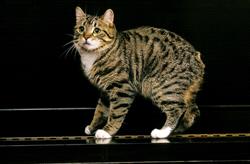Manx Syndrome in Cats
Manx syndrome (sacrocaudal dysgenesis, sacrocaudal agenesis) is an array of problems involving the function of the hind legs, urinary bladder, and colon of a tailless cat. In affected cats, the spine and spinal cord are shortened because the last few vertebrae and spinal segments have not developed normally.
Manx cat standing on piano

Manx cat
Manx syndrome is most common in Manx cats. The British breed from the Isle of Man is typically tailless. Manx syndrome has been occasionally described in mixed-breed tailless cats. Sacrocaudaul dysgenesis is rare in dogs, however, clinical signs are similar.
Inheritance
Manx syndrome is inherited as an autosomal dominant trait in the Manx cat, meaning the Manx syndrome trait can be passed down from just one parent's genes and the offspring will have the trait. However, the degree of spinal malformation can vary. All Manx cats, with or without a tail, have the mutant gene and can produce tailless offspring. Neurological problems are most common in tailless cats.
Signs
Some tailless cats have mild or no neurologic changes, while others have severe neurologic deficits.
Signs depend on how severely the cat’s spinal cord is affected. Significantly affected cats may die in utero or be euthanized soon after birth. Signs are usually recognized when the kitten starts to walk, anywhere from weeks to months after birth. Clinical signs may include an abnormal pelvic limb gait (back legs), urinary and fecal incontinence, lack of sensation in the hind legs and around the openings of the anus and urethra, and some level of hind-end paralysis. Those cats whose hind legs do not function the way they should are usually unable to participate in some typical cat behaviors, such as jumping, and need to be kept as indoor cats.
Signs can include:
- Tailless
- Urinary or fecal incontinence
- Secondary urinary tract infections
- Urinary scalding and staining
- Constipation
- Partial paralysis of the hind legs, which can cause difficulty walking
- Bunny hopping gait
- Lack of sensation of the skin around the anal/perineal area
- Stance in which the cat walks on their entire foot instead of the toes
- Rectal prolapse
- Some cats may develop megacolon, where the colon becomes abnormally dilated and loses its ability to contract due to long-term, chronic constipation.
Diagnostics and Treatment
Your veterinarian will take a thorough medical history and perform a complete physical examination to make the diagnosis. Some radiographs or other imaging tests may be recommended, as well as a urinalysis, a neurologic examination, and a bacterial culture to test for a urinary tract infection.
There is no curative treatment. All that can be offered is supportive care and keeping the cat clean while managing any incontinence, hygiene, megacolon, urinary tract infections, and constipation. Daily grooming is necessary for cats incapable of controlling their bowels or bladder as chronic skin contact with urine or feces can start an ongoing struggle with lifelong skin irritation and urinary infections that must be treated. If your cat is incontinent, your veterinarian can show you how to manually empty the bladder to help prevent urine scald and bladder infection. Diapers can be used to prevent soiling if your cat will tolerate them. Stool softeners can help ease constipation.
Prevention
Parents of affected cats should not be bred again to prevent suffering.